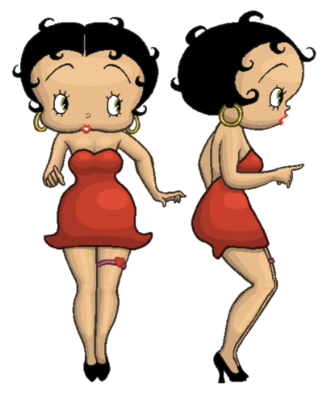
Boop, Betty
Betty Boop is regarded as one of the first and best known sex symbols on the animated screen; she is a symbol of the Depression era, and a reminder of the more carefree days of Jazz Age flappers. Her popularity was drawn largely from adult audiences, and the cartoons, while seemingly surreal, contained many sexual and psychological elements[clarification needed], particularly in the 1932 “Talkartoon” Minnie the Moocher (1932), featuring Cab Calloway and his orchestra.
Minnie the Moocher defined Betty’s character as a teenager of a modern era, at odds with the old-world ways of her parents. In the cartoon, after a disagreement with her strict parents, Betty runs away from home, accompanied by her boyfriend Bimbo, only to get lost in a haunted cave. A ghostly walrus (rotoscoped from live-action footage of Calloway) sings Calloway’s song “Minnie the Moocher”, accompanied by several other ghosts and skeletons. This haunting performance sends the frightened Betty and Bimbo back to the safety of home. “Minnie the Moocher” served as a promotion for Calloway’s subsequent stage appearances and also established Betty Boop as a cartoon star. The eight Talkartoons that followed all starred Betty, leading her into her own series beginning in 1932. With the release of Stopping the Show (August 1932), the Talkartoons were replaced by the Betty Boop series, which continued for the next seven years.
Betty Boop was unique among female cartoon characters because she represented a sexual woman. Other female cartoon characters of the same period, such as Minnie Mouse, displayed their underwear or bloomers regularly, in the style of childish or comical characters, not a fully defined woman’s form. Many other female cartoons were merely clones of their male co-stars, with alterations in costume, the addition of eyelashes, and a female voice. Betty Boop wore short dresses, high heels, a garter, and her breasts were highlighted with a low, contoured bodice that showed cleavage. In her cartoons, male characters frequently try to sneak peeks at her while she is changing or simply going about her business. In Betty Boop’s Bamboo Isle, she does the hula wearing nothing but a lei, strategically placed to cover her breasts, and a grass skirt. This was repeated in her first cameo appearance in Popeye the Sailor (1933). There was, however, a certain girlish quality to the character. She was drawn with a head more similar to a baby’s than an adult’s in proportion to her body. This suggested the combination of girlishness and maturity that many people saw in the flapper type, which Betty represented.
While the character was kept pure and girl-like onscreen, compromises to her virtue were a challenge. The studio’s 1931 Christmas card featured Betty in bed with Santa Claus, winking at the viewer. The Talkartoons The Bum Bandit and Dizzy Red Riding Hood (both 1931) were given distinctly “impure” endings. Officially, Betty was only 16 years old, according to a 1932 interview with Fleischer (although in The Bum Bandit, she is portrayed as a married woman with many children and with an adult woman’s voice, rather than the standard “boop-boop-a-doop” voice).
Attempts to compromise her virginity were reflected in Chess-Nuts (1932) and most importantly in Boop-Oop-a-Doop (1932). In Chess-Nuts, the Black King goes into the house where Betty is and ties her up. When she rejects him, he pulls her out of the ropes, drags her off to the bedroom and says, “I will have you”. The bed, however, runs away and Betty calls for help through the window. Bimbo comes to her rescue, and she is saved before anything happens. In Boop-Oop-a-Doop, Betty is a high-wire performer in a circus. The ringmaster lusts for Betty as he watches her from below, singing “Do Something”, a song previously performed by Helen Kane. As Betty returns to her tent, the ringmaster follows her inside and sensually massages her legs, surrounds her, and threatens her job if she does not submit. Betty pleads with the ringmaster to cease his advances, as she sings “Don’t Take My Boop-Oop-A-Doop Away”. Koko the Clown is practicing his juggling outside the tent and overhears the struggle inside. He leaps in to save Betty, struggling with the ringmaster, who loads him into a cannon and fires it. Koko, who remained hiding inside the cannon, knocks the ringmaster out cold with a mallet, while imitating the ringmaster’s laugh. Koko then inquires about Betty’s welfare, to which she answers in song, “No, he couldn’t take my boop-oop-a-doop away”. According to Jill Harness of Mental Floss, these portrayals of Boop fighting off sexual harassment on the animated screen made many see her as a feminist icon
